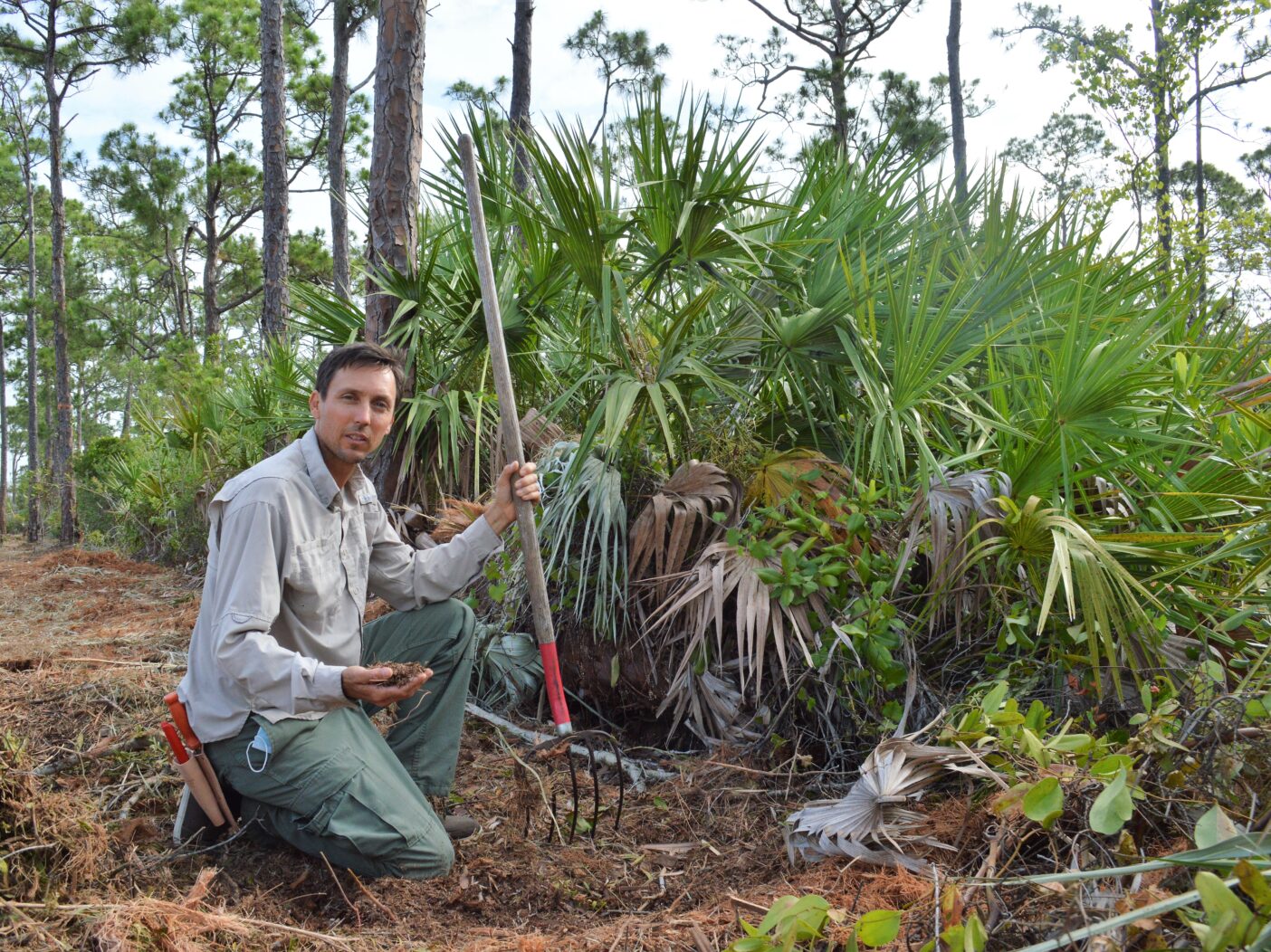
Director of Natural Resources Eric Foht explains how fire sparks nature’s renewal and why we should appreciate this elemental process.
I looked up at the rising column of smoke and the billowing cloud amassing overhead. Below, orange flames engulfed trees, shrubs, palms, and grasses creating a symphony of sounds in the process — a prolonged tearing, a light crackle, and short bursts like water on a hot oiled pan. The smoke was laden with pine resin, and I wondered: Did it alert the trees downwind of what was coming?
Collier-Seminole State Park’s prescribed fire team and a cadre of volunteers from other agencies, including myself, had set this fire on the northeast side of the park, intentionally, just a few hours earlier one morning last spring.
The fire was slow to start, as is sometimes the case, but once the relative humidity dropped, we watched with satisfaction (and a great deal of attentiveness) as the blaze intensified. This was a prescribed burn, meant to help rather than hurt the land. The land managers at Collier-Seminole had spent months planning, preparing, and waiting for an opportunity to light it safely.
As a native Floridian and Naples Botanical Garden’s Director of Natural Resources, I’m fascinated with fire and its relationship to the plants and animals here. In Southwest Florida, summer is the natural fire season, as lightning is abundant, but natural fires can occur in other seasons when conditions are right. These seasonal occurrences have been happening faithfully for thousands of years, and fire has literally shaped Florida’s ecosystems. Without it, we would not have pine flatwoods or the marsh systems of our magnificent Everglades. Fire keeps hardwood trees from infiltrating these habitats. It maintains the iconic open expanse of the River of Grass and grants the slash pines unique status as the flatwoods’ only overstory tree.

Today, wildfires are often extinguished before they can do their jobs. This is necessary to prevent damage to homes and properties in developed areas, but in many of Florida’s diverse natural habitats, suppressing fire can cause more harm than the fire itself. So much plant and animal life depend on fire’s rejuvenating force. That is why we need specially trained land managers to light prescribed burns in ecosystems that depend on fire. This practice protects both people and the land. The longer we go without fire, the more plant matter — fire’s fuel accumulates. Frequent fires are less intense than a once-in-a-great-while blaze.
Whenever I watch a prescribed burn, I discover more about the relationships between fire, plants, and wildlife, and how they interact in sometimes surprising ways.
At the Collier-Seminole fire, I scanned the sky and noticed a turkey vulture soaring in the lift of the rising heat and smoke. Turkey vulture wings are perfectly suited to use thermals — rising columns of warm air — from a hot summer day or, in this case, a fire. I contemplated how long turkey vultures have been making use of this free ride. Probably as long as there have been fires in Florida, which means a very long time.
South Florida plants are equally suited to fire. The shape of the plants, the compounds within them, and their life cycles are all designed around nature’s fire cycle.

Saw palmetto, for example, was built to harness the power of fire. Eighty percent of the plant is below ground, and it can withstand temperatures of nearly 2,000 degrees Fahrenheit! Saw palmettos resprout easily after a fire and have even evolved flammable compounds in their leaves. This promotes the spread of fire, helping keep hardwood trees from moving in and shading them out.
Slash pine takes an almost opposite approach, developing in a way that repels fire. Look closely at a slash pine tree. You will see that they shed their lower branches. This is thought to be so fire can’t climb their trunks as readily. Their needled canopy towers above the fire and avoids the most intense heat. Their thick, layered bark, like the pages of a book, protects the living tissue underneath.
And then there is Florida rosemary. It dies in fire, but its death makes way for the plant’s seeds to sprout. The young plants grow in the ashes of their parent and are nourished by the sacrifice.
Each time I volunteer on a prescribed burn, I learn so much from the people I am with and the plants I am around. Witnessing nature’s power is humbling. As I grow in my understanding of fire and our ecosystem’s need for it, I grow in my desire to someday bring this force to the Garden.
The Garden’s natural areas would do well with a carefully controlled prescribed burn. Fire, in fact, is the only thing that will ensure some of our rare and beautiful native species survive in the long term. By listening to and studying the land, we can reintroduce this elemental process in an act of reciprocity, our thanks for everything the land does for us. We can be a force for good for nature. And if you, like me, are awed by the power of fire and the renewal that follows, you may find yourself rejuvenated right along with the land.
This article originally appeared in the 2021 issue of Conserve.
 About the Author
About the Author
Eric Foht is the Garden’s Director of Natural Resources.


